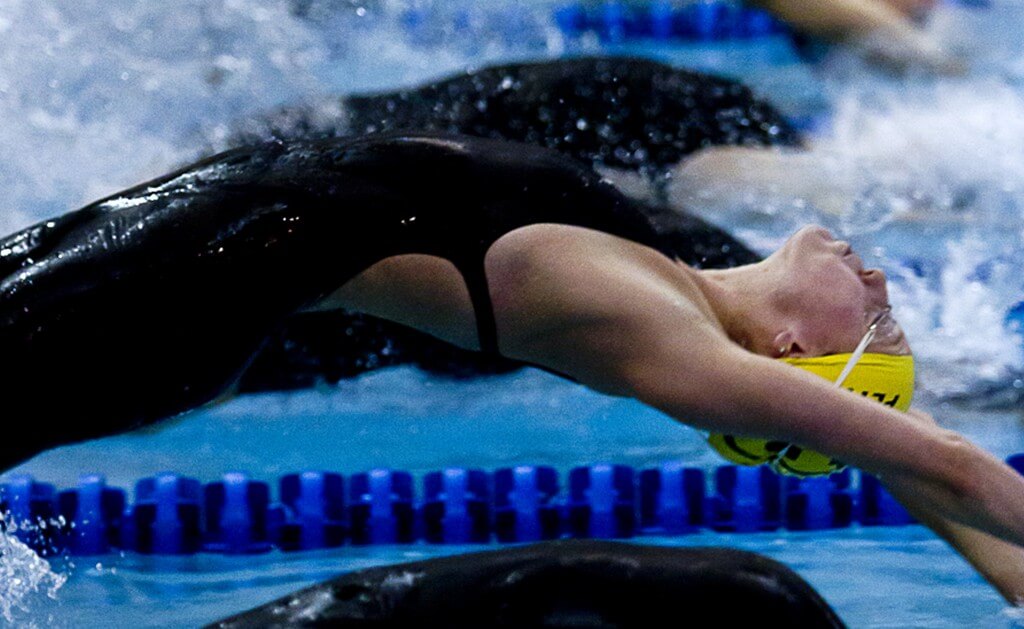How Much Swimming Training is Right for Me?

By Wayne Goldsmith
How Much Swimming Training is right for me? This is without doubt the Biggest Question in Swimming today and is probably the most important question ever asked in the sport.
No – it’s not about Michael Phelps’ comeback and his chances of Olympic Gold in 2016.
No – it’s not about the chances of Cal winning NCAAs again next year.
And No – it’s certainly not about the state of the economy (yawn).
The Biggest Question in Swimming is…..
How Much Swimming Training is Right for me?
The War of Words on Water.
Over the past few years there’s been a philosophical battlefield in swimming – a battle between the traditionalists view of training – the More is Better brigade – who passionately believe that the path to success is by working harder, more often than your opposition and the Less is Better disciples who believe they’ve found a new direction – a new mantra in swimming with ultra high intensity, race pace, low volume training.
So who is right?
More is Better training methods: Pros and Cons.
Pros:
- 100 years of coaching supports the More is Better training model. Every great swimmer produced over the past 100 years of the sport has been coached (in general) through the traditional approach to training;
- It improves the “average”: i.e. if the average fitness of my team is higher than the average fitness of your team – then – on average we’ll beat you most of the time;
- It works well in big teams with low numbers of coaches and where individualized training is difficult to implement;
- It provides confidence. Confidence is knowing. If a swimmer knows they’ve trained harder, more often than their opposition and harder than they’ve ever trained in the past. then they can be reasonably confident of a great result at their next meet.
Cons:
- Broken-egg coaching. The traditional swimming coaching method has relied on what we call broken-egg coaching. If you throw 10000 eggs against a wall, chances are that one egg, laid with a naturally thicker shell might survive the impact and fall. This concept has been behind the traditional approach to training volume for a long time;
- It can set up a mind-set that swimming is only about physical preparation and physiology when it is also about the mental side of performance, skills, techniques, attitude, commitment, nutrition, recovery, self-management and various other factors.
- There’s a relatively higher risk of overuse injury, illness and breakdown;
- “More is better” training can be dull, boring, uninteresting and disengaging owing to the repetition required.
Less is Better training methods: Pros and Cons.
Pros:
- It makes sense to train at the same speed and with the same stroke mechanics as you’ll need to perform at your best in your next race;
- The fundamental training principle of “specificity” (i.e. you get what you train for) overwhelmingly supports the “Less is better” approach;
- Swimming less distance means you’ll never be overly fatigued and therefore you can swim faster – more often;
- The risk of overuse injury, illness and burnout should be reduced with a lower training volume.
Cons:
- It demands that swimmers are highly motivated and 100% focused on skills, technique and maintaining precise race pace at all times during their training;
- It is very difficult to implement an individualized approach to training in a typical age group swimming program with crowded lanes full of swimmers of various ages, levels of experience and different levels of ability;
- It assumes the swimmers have the background in skills, technique and fitness to complete the workout to the prescribed standard;
- It’s appropriateness to distance swimmers, triathletes and open water swimmers is questionable.
How Much Swimming Training is Right for Me?
The right amount of training for you is whatever makes you swim faster.
They’ll be some swimmers who will benefit greatly from the new “Less is Better” approach. They’ll be just as many who will continue to benefit from the traditional approach of high volume, high intensity workouts.
However, regardless of the approach you believe is right for you, More is Better or Less is Better, ultimately your swimming success has very little to do with WHAT you do in training…..it’s all HOW you train that makes all the difference.
1 lap swum with excellent technique, controlled breathing, outstanding skills and with precise pacing is better than 100 swum with poor technique, inefficient breathing, sub-standard skills and inaccurate pacing.
Coaches set workouts, write sessions and plan programs.
Swimmers, through the decisions and choices they make every time they push off for another lap determine how effective that workout will be.
Don’t count the laps…make every lap count.






“1 lap swum with excellent technique, controlled breathing, outstanding skills and with precise pacing is better than 100 swum with poor technique, inefficient breathing, sub-standard skills and inaccurate pacing.”
Maybe if you are training for the 50, but if you really think that swimming one 25 with perfect technique is a better way to train for the 400 IM, 500, 1000 or the mile than struggling to make it through 5 x 500 on an interval that gives you about 15 to 20 seconds rest while you are more or less redlining the whole time, then I’ve got a wonderful opera house down under to sell to you.
As my good friend Wayne points out – doing less laps can be risky. To get the same or better results “less laps” requires the coach to spend focused time and energy on the technical aspects of the sport. But for the long haul, I’d rather see a swimmer go through our sport loving the experience and using it as a lifetime sport. As a college coach I prefered getting the “fresh” swimmer who has a lot more “in the tank”. My preference is a little less performed better– but I didn’t tell that to Tyler Clary this morning when we ended practice with 4×400 IM (time stays as stroke count reduces).
Cool set, Dave. Is Lochte doing it too?
Interesting, I saw the approach Wayne was talking about when was over at NC observing a couple of David’s sessions earlier this year. I took the approach and have been following the less approach with our sprinters with some huge successes. Less injuries, happier swimmers and some huge PB’s
Thanks David for your time when I was over. Did Ryan appreciate the swim hat ?
Nice article! Thank you Wayne!
Right on Wayne!
I agree with everything you have said here EXCEPT the part about distance swimmers. I trained for nearly a year to break the Masters WR in the 400 freestyle doing race pace 50s and 25s only. I think race pace training using USRPT is better for distance than for sprinters!
In any event, you did a good job of explaining the pros and cons of traditional and race pace training. I especially liked the fact that you included the mental aspect as an important part of the total training picture.
Wayne,
I enjoyed your article. As for the cons for the Less group, I think that implementing a workout that is specific for a diverse group that I have in a typical workout – strokes, experience, mastery and event duration is actually much easier and more efficient with a “less” workout. I find that the whole group can be appropriately challenged and well organized in seven or eight lanes of SCY training. As Dave M points out, there is no doubt there is a place and high value for training (in my opinion) that is traditional in nature for all types of swimmers across all events.